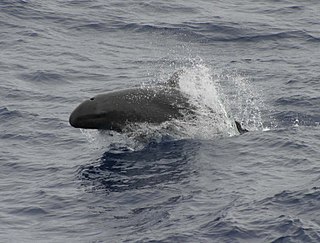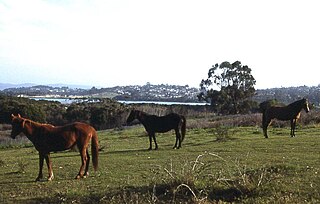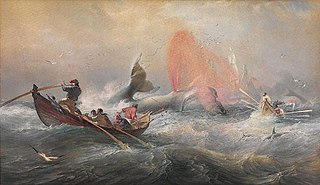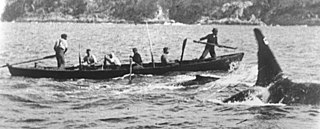
The blue whale is a marine mammal belonging to the baleen whale suborder Mysticeti. Reaching a maximum confirmed length of 29.9 meters and weight of 173 tonnes, it is the largest animal known to have ever existed. The blue whale’s long and slender body can be various shades of grayish-blue dorsally and somewhat lighter underneath.

The killer whale or orca is a toothed whale belonging to the oceanic dolphin family, of which it is the largest member. Killer whales have a diverse diet, although individual populations often specialize in particular types of prey. Some feed exclusively on fish, while others hunt marine mammals such as seals and other species of dolphin. They have been known to attack baleen whale calves, and even adult whales. Killer whales are apex predators, as no animal preys on them. A cosmopolitan species, they can be found in each of the world's oceans in a variety of marine environments, from Arctic and Antarctic regions to tropical seas, absent only from the Baltic and Black seas, and some areas of the Arctic Ocean.

Whaling is the hunting of whales for their usable products such as meat and blubber, which can be turned into a type of oil which became increasingly important in the Industrial Revolution. It was practiced as an organized industry as early as 875 AD. By the 16th century, it had risen to be the principal industry in the coastal regions of Spain and France. The industry spread throughout the world, and became increasingly profitable in terms of trade and resources. Some regions of the world's oceans, along the animals' migration routes, had a particularly dense whale population, and became the targets for large concentrations of whaling ships, and the industry continued to grow well into the 20th century. The depletion of some whale species to near extinction led to the banning of whaling in many countries by 1969, and to a worldwide cessation of whaling as an industry in the late 1980s.

The humpback whale is a species of baleen whale. It is one of the larger rorqual species, with adults ranging in length from 12–16 m (39–52 ft) and weighing around 25–30 metric tons. The humpback has a distinctive body shape, with long pectoral fins and a knobbly head. It is known for breaching and other distinctive surface behaviors, making it popular with whale watchers. Males produce a complex song lasting 10 to 20 minutes, which they repeat for hours at a time. All the males in a group will produce the same song, which is different each season. Its purpose is not clear, though it may help induce estrus in females.

Whale watching is the practice of observing whales and dolphins (cetaceans) in their natural habitat. Whale watching is mostly a recreational activity, but it can also serve scientific and/or educational purposes. A study prepared for International Fund for Animal Welfare in 2009 estimated that 13 million people went whale watching globally in 2008. Whale watching generates $2.1 billion per annum in tourism revenue worldwide, employing around 13,000 workers. The size and rapid growth of the industry has led to complex and continuing debates with the whaling industry about the best use of whales as a natural resource.

The false killer whale is a species of oceanic dolphin that is the only extant representative of the genus Pseudorca. It is found in oceans worldwide but mainly frequents tropical regions. It was first described in 1846 as a species of porpoise based on a skull, which was revised when the first carcasses were observed in 1861. The name "false killer whale" comes from the similar skull characteristics to the killer whale.

Plettenberg Bay, nicknamed Plet or Plett, is the primary town of the Bitou Local Municipality in the Western Cape Province of South Africa. As of the census of 2001, there were 29,149 population. It was originally named Bahia Formosa by early Portuguese explorers and lies on South Africa's Garden Route 210 km from Port Elizabeth and about 600 km from Cape Town.

Cetacean stranding, commonly known as beaching, is a phenomenon in which whales and dolphins strand themselves on land, usually on a beach. Beached whales often die due to dehydration, collapsing under their own weight, or drowning when high tide covers the blowhole. Cetacean stranding has occurred since before recorded history.

The New Bedford Whaling Museum is a museum in New Bedford, Massachusetts, United States that focuses on the history, science, art, and culture of the international whaling industry, and the "Old Dartmouth" region in the South Coast of Massachusetts. The museum is governed by the Old Dartmouth Historical Society (ODHS), which was established in 1903 "to create and foster an interest in the history of Old Dartmouth." Since then, the museum has expanded its scope to include programming that addresses global issues "including the consequences of natural resource exhaustion, the diversification of industry, and tolerance in a multicultural society." Its collections include over 750,000 items, including 3,000 pieces of scrimshaw and 2,500 logbooks from whaling ships, both of which are the largest collections in the world, as well as five complete whale skeletons. The museum's complex consists of several contiguous buildings housing 20 exhibit galleries and occupying an entire city block within the New Bedford Whaling National Historical Park, although operated independently.

Eden is a coastal town in the South Coast region of New South Wales, Australia. The town is 478 kilometres (297 mi) south of the state capital Sydney and is the most southerly town in New South Wales, located between Nullica Bay to the south and Calle Calle Bay, the northern reach of Twofold Bay, and built on undulating land adjacent to the third-deepest natural harbour in the southern hemisphere, and Snug Cove on its western boundary. At the 2016 census, Eden had a population of 3,151.

Old Tom was a killer whale (orca) known to whalers in the port of Eden on the southeast coast of Australia. Old Tom measured 22 feet (6.7 m) and weighed 6 tons, with a 3.33 feet (1 m) skull and teeth about 5.31 inches (13.4 cm) long.

Twofold Bay is an open oceanic embayment that is located in the South Coast region of New South Wales, Australia.

Whaling in Australian waters began in 1791 when five of the 11 ships in the Third Fleet after landing their passengers and freight at Sydney Cove then left Port Jackson to engage in whaling and seal hunting off the coast of Australia and New Zealand. The two main species hunted by such vessels in the early years were right and sperm whales. Later, humpback, bowhead and other whale species would be taken.

Whaling was one of the first viable industries established in the Swan River Colony following the 1829 arrival of British settlers to Western Australia. The industry had numerous ups and downs until the last whaling station closed in Albany in 1978.
Albert Wood Aspinall was an Australian stonemason and builder. He was an expert in constructing round towers and buildings.
2EC is a radio station broadcasting to the South Coast of New South Wales, Australia, specifically the local government areas of Eurobodalla and Bega Valley. It is owned by East Coast Radio Pty. Ltd, which is a subsidiary of Grant Broadcasters.

The killers of Eden or Twofold Bay killers were a group of killer whales known for their co-operation with human hunters of cetacean species. They were seen near the port of Eden in southeastern Australia between 1840 and 1930. A pod of killer whales, which included amongst its members a distinctive male called Old Tom, would assist whalers in hunting baleen whales. The killer whales would find target whales, shepherd them into Twofold Bay or neighbouring regions of coast, and then often swim many kilometres away from the location of the hunt to alert the whalers at their cottage to their presence and often help to kill the whales.

Glenmorgan is a town in the Western Downs Region and a locality split between the Western Downs Region and the Maranoa Region, Queensland, Australia.

Hayward Area Historical Society(HAHS) is a nonprofit organization dedicated to documenting the history of the city of Hayward, California and adjacent communities. These areas include San Lorenzo, Ashland, Cherryland, Castro Valley, Fairview, the former communities of Russell City, Mount Eden, Schafer Park, and other parts of unincorporated Alameda County. The society was founded in 1956. Their museum in Downtown Hayward closed in 2012. Their new facility opened nearby in 2014.

The Eden Valley Museum is a local history museum housed within a preserved example of Kentish vernacular architecture that has been Grade II* Listed. It is in the High Street of the historic market town of Edenbridge, Kent. The museum holds notable collections demonstrating the history of cricket ball making, tanning as well as archaeology and an extensive archive of local information. The museum is also notable as the home of a needlework box made by a German POW during World War Two. The box was featured as part of the BBC's 'A History of the World in 100 Objects' project.


















